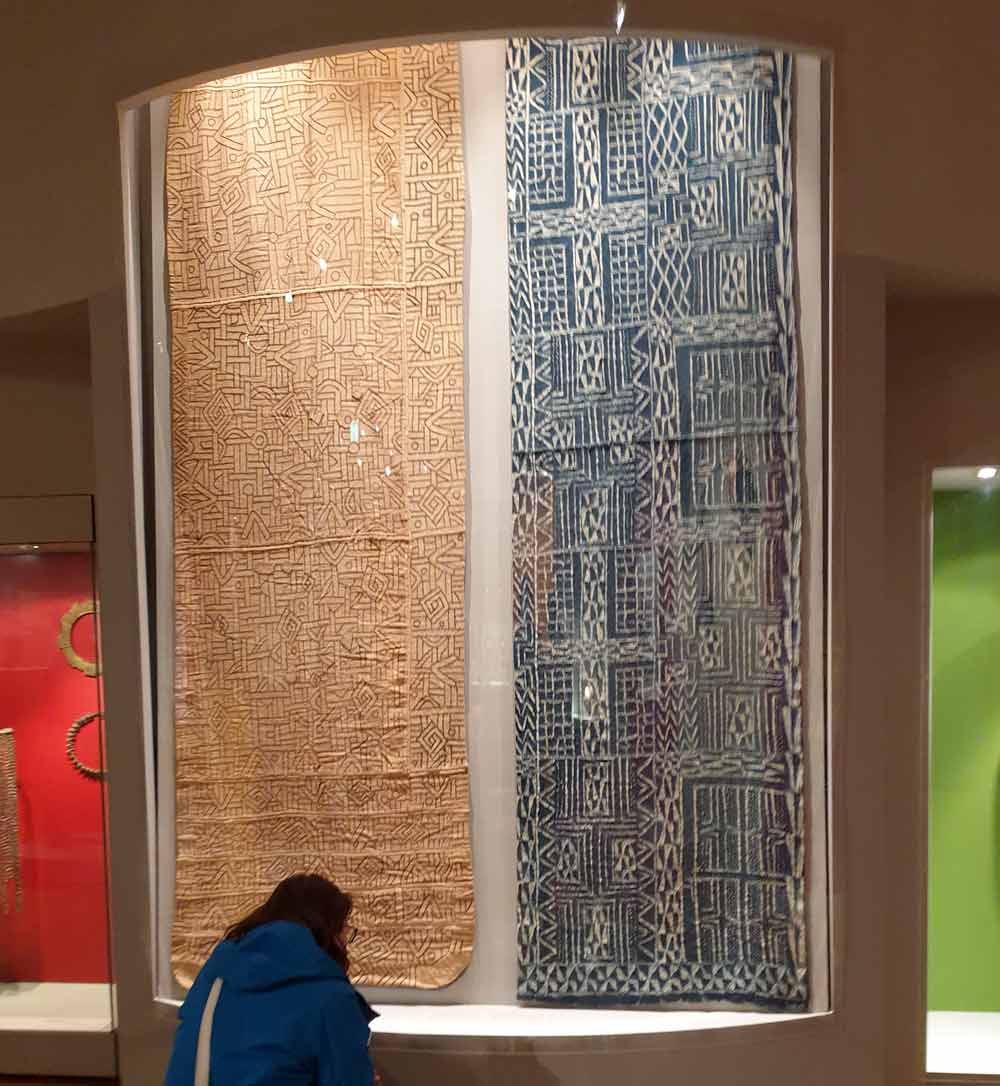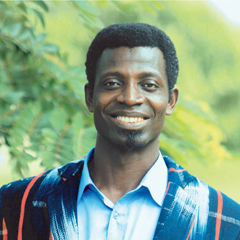In my encounter with the exhibits of the Permanent Exhibition of the African Collection in the Museum Fünf Kontinente, one of the African textile collections that striked me from a distance, and possess high tendency of inviting viewers attention is the ndop fabric. I moved closer to the exhibit to observe its uniqueness in terms of its structural and surface characteristics. From my curious observation, I realised that the ndop fabric has simple geometrical linearity and patterns, yet, spiced with complex dynamism of the arrangements of these patterns that evoke the artistic principles of variety, harmony and technical constrast. This treatment breaks monotony and creates multi-sectional visual interest in the fabric design despite its monochromatic colouration. These observable details, characteristic of authentic African fabric, pulled my visual curiosity to the exhibit. Indeed, it is an epitome of authentic African fabric.
Africans had long developed unique structural and surface decorative techniques for creating fabrics. Structural decorative techniques concern itself with the basic forming or construction of the fabric. Weaving, bonding, netting, lacing and felting include the structural decorative technique. Surface decorative techniques deal with the colourations and other embellishments to improve the surface quality or appearance of the fabric. Examples are dyeing, painting, printing, embroidery and applique. The ndop fabric was struturally woven with handspun cotton yarns in plain weave format in the form of stripes. The stripes were joined together with the aid of a needle to form a wide sheet of fabric after which the sheet of fabric was subjected to resist dyeing to create attractive patterns. In resist dyeing, portion of the fabric are prevented from dye absorption. Techniques used in resisting dye penetration include tying, tritiking (sewing), waxing, folding, twisting and coiling, and or a combination of these techniques. In the case of the ndop fabric, tritiking technique was used where raffia fibre cordage was used to stitch the desired patterns such that it could resist dye penetration after which the fabric was immersed into indigo dye solution locally extracted from plants. After the required time for dyeing, the fabric was removed from the dyebath, rinsed, dried and unstitched to reveal the patterns.
The skilful use of regular geometry in seemingly irregular and asymmetric arrangement style complemented by the handmade rendition, the technical finesse in stitching to create the intricate pattern and the entire arrangement of the geometrical shapes in simple repetitive format create high visual appeal of the surface quality of the fabric. Per its visuality, one may see it as a printed fabric, yet, it was created using resist dyeing effect. The slight unevenness in the dye absorption resulting in patchy shades of the indigo at certain portions of the fabric adds to its creative uniqueness. The varying border designs of the fabric bond well in creating a sense of unity in the entire composition.

Ndop fabric. Detail. (© Museum Fünf Kontinente / Photo Ernst Wagner)
Besides the observable trenchant characteristics of the fabric, it also has social and cultural contexts in the Bamum society. The ndop is more than just a fabric in terms of its usage and communicative significance. The fabric is symbolically linked to death, afterlife, and powerful spirits connected to life. Consequently, it is worn during funerals and traditional religious rites. Apart from this, it is worn for its aesthetical reasons.
The ndop fabric falls within the repertoire of indigenous and authentic African fabric creation and decoration culture, which include the Korhogo Cloth (Ivory Coast), Adire (Nigeria), Bogolanfini (‘mud cloth’ from Mali), Kente and Adinkra (Ghana), Smock or fugu (Ghana) and Dogon Cloth. Common to these fabric printing technology of Africa is that the fabrics used are usually cotton, with ocassional usage of silk or velvet. In the case of Ghana, Adinkra printing is made with cutout stamps which are dipped into dyes and transferred on the fabric to register the designs while in Kente and fugu, the hand spun cotton yarns are dyed in different colours and used for weaving. The ndop is dyed. Availble records indicate that indigenous dyeing of fabrics in Ghana, in many instances, were done by uniform application of dyes to the entire fabric. This means that fabrics were immersed without resisting some portions. Kobene (brick red) and Birisi (blue-black) fabrics of the Asante people of Ghana are examples.
As a textiles and fashion educator and artist, I guide learners to examine the hand-made indigenous fabric decorative characteristics of Africa including the ndop fabric in order for them to understand and apply them in their fabric design. In this sense it inspires my fabric designs and that of my students. I also empower them through my teaching with historical knowledge about the contributions of Africa to the global textiles design culture. This is because the unique patterns and characteristics found in the repertoire of indigenous and authentic African fabric technological culture have been imitated with computer effects and printed by some European and Asiatic fabric brands, mostly sold in Central and West Africa. These foreign brands have been deceptively labelled with an umbrella term, African prints, to lure and deceive buyers. The ndop fabric has valuable educational relevance in teaching and learning and historical understanding of African fabric making technology in this context.

Presentation at the museum 2021 (Photo Ernst Wagner)
This article is part of a gallery: Perspectives from Ghana on Museum Objects in Germany. Published in January 2021



